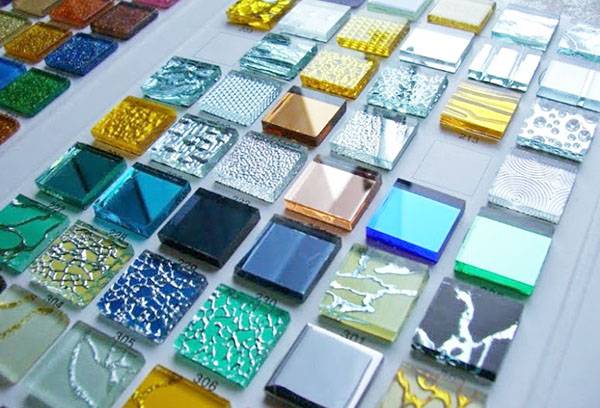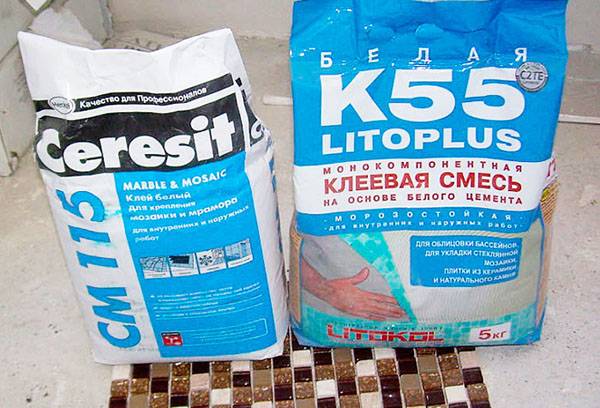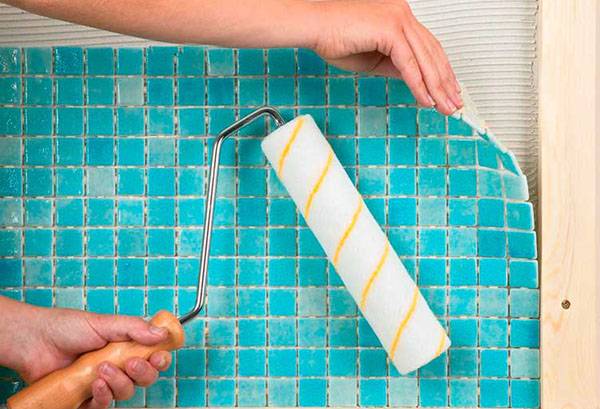How to choose glue for mosaic and glue it at home?
Are you planning to make a mosaic backsplash in the kitchen or line the walls in the bathroom? Then you've probably already thought about how to find the right mosaic adhesive and save money at the same time. If a plan has already matured in your head to replace the special composition with ordinary cheap tile adhesive, we hasten to tell you why it is better not to do this and which adhesive you still need to choose.

Why is it better to choose special glue?
Sometimes it seems that all these special compounds are nothing more than an attempt to rip off more money from the buyer. There is cement tile adhesive, so why can't you put mosaic tiles on it?
- The main problem is that mosaics are often made of glass - ceramic ones look more massive, and there is less choice for them. Accordingly, gray glue will be visible through transparent or translucent tiles, distorting its color.
- Regular tile adhesive contains quite large particles of sand, which can affect adhesion - the adhesion of the adhesive to the mosaic. It’s not for nothing that plasticizers are added to special mosaic glue for better adhesion!
- Also, because of the sand, it will be difficult for you to follow the laying technology, because in our case you need to take a very fine comb, and it will be inconvenient to work with such a grainy composition. Plus, with such glue it will be more difficult to achieve the desired thickness, which should not exceed a few millimeters.
By the way
If the glass is cloudy and almost opaque, a gray backing will simply make the color appear a little duller and darker. If this is not critical for you, you can try to save a little.
If you want to bypass the system and glue the mosaic to white compounds like Teplon, know: they, of course, are white and fine-grained, but they are gypsum plaster, not glue, so the mosaic tiles will hold until the first slam of the door.
What about liquid nails and silicone? Experience shows that the mosaic does not stick to them so badly, but it only makes sense to use them if you are using the mosaic element as decoration on a wall with a finished finish. If the repair has just begun, choose a special glue: this way the coating will come out smoother and will hold tighter.
That is, by and large, the mosaic can theoretically be held on by different glues, but why go to such lengths when the ideal option has already been invented? With other compositions, the end result may not please you, and the work process will be much more labor-intensive. In addition, no one can guarantee long-lasting adhesion, and redoing a mosaic area is much more difficult than re-pasting wallpaper.
What to glue the mosaic onto?
You already understand that it is better not to replace mosaic glue with anything, but what composition should you buy? In fact, there are many brands, but they all produce similar mixtures, the difference in the work with which you will notice only if you work with each of them. If you are not on the construction team, but hope to lay tiles for the first and last time in your apartment, here’s what you should pay attention to.
- The best adhesive for mosaic tiles is white, especially if it is glass.Many companies have this glue in powder format: MAPEI, Lugato, Index, Ceresit, Knauf, Litokol and others. If this is not specific work, such as laying tiles in a pool, it is enough to ask a consultant what is available and make a choice in favor of an option with a suitable price.
- Operating conditions also matter: the higher the load on the area, the more elastic the glue should be and the more plasticizer should be added. True, this is usually not so critical for home repairs
- Consider whether it is enough to dilute the powder with water or whether you will need a special latex plasticizer. Now such emulsions are added even to ordinary tile adhesive if they need to guarantee enhanced adhesion, water resistance and elasticity.
By the way
The plasticizer can be added to the glue along with water in different proportions; it is not always necessary to mix the powder completely on it.
- Check the expiration date of the product: mosaic adhesives do not last for centuries. The shelf life of powders usually ranges from 6 to 12 months, and no one guarantees that the mosaic will adhere well to expired glue.
- The choice of adhesive may vary depending on the substrate surface: for concrete and plaster, the elasticity of the adhesive may be less than for waterproofing or old tiles.
- In addition to the price, you should focus on the volume of the mixture: white mosaic glue is often sold in large bags of 20-25 kg, but if you need to glue only a couple of sheets on a mesh, it may be more convenient to buy a smaller volume, even if in terms of 1 kg it will cost more.
Advice
In many large construction stores you can buy already diluted glue by weight, however, in this case you need to start work as quickly as possible.
How to glue mosaic tiles?
We've sorted out the adhesive composition, but how to glue the mosaic to the base? In fact, the process is only slightly different from installing tiles, and the differences depend on what type of mosaic you choose.
In general, the mosaic finishing process looks like this.
- The surface is leveled to the maximum, since small tiles will take the bends of any irregularities, and it will not be possible to level them with a thin layer of glue during the work process.
- You need to remove dust and dirt from the base, and be sure to prime it for better adhesion.
- The glue is applied after the primer has dried in a thin layer: only 2.5-4 mm, depending on the thickness of the tile. Then it is leveled with a fine comb or notched trowel to 2-4 mm. In this case, 2-3 sheets of glue are applied to the laying area, otherwise it will dry out ahead of time.
- The tile is applied to the glue and leveled with a rubber float or something flat and even using slapping movements.
- The glue sets in about a day, but during the first hours it is better to keep an eye on whether the canvas has slipped: within 2-3 hours, depending on the glue, imperfections can usually be corrected.
And a little about the differences.
- If the mosaic is on a mesh, then you can remove the glue from the grout joints after several hours, until the glue has completely hardened, only carefully.
- If the mosaic is on a paper base, then you need to remove the paper and rub the seams after the glue has completely dried. The process of cleaning off completely cured glue is not easy, so if you have the opportunity to glue directly onto epoxy grout, you can consider this option.
- How to glue a mosaic without a base in the form of a grid or paper? Also, only the glue needs to be applied to a small area, because the speed of work is much lower.
In fact, gluing mosaic tiles at home is not that difficult if you follow the instructions and choose the glue responsibly.

